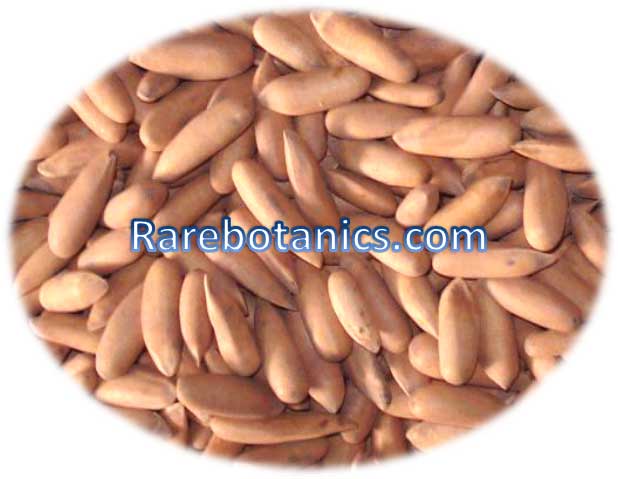Pine Nut Kernels
Pine nut seeds inside the pine nut seed shells in called as pine nut kernels. Also known as chilgoza and botanical name is pinus gerardiana. Trees of pine nuts grows well on stones and is also named as Stone nuts.
Pine trees are one of the cone bearing conifers and their reproductive organs are cones. These cones contains pine nuts which are the edible seeds and locally called Chilghoza.These nuts are crunchy and buttery pieces that can used as snacks. The pine trees can endure severe cold, high winds and excessive drought. In Pakistan, pine nuts are found in Baluchistan, Khyber Pakhtunkhwa, Northern areas (Gilgit, Chitral & Waziristan) and Kashmir but the Suleiman range contains the world’s largest reservoir of pine nuts which are spaced over 260 kilometers. About 20% of pine trees are located in forests of Pakistan.
Threats to Pine Trees
Pine forests are highly threaten due to uncontrolled cutting of trees for fuel, space and timber. Another reason is the high demand of pine nut collection by the local communities, hence they gathered all the cones they find which leads to left only few cones for natural regeneration. Pine forests are the natural habitats of wildlife such as Markhor (Capra falconeri) which is the national animal of Pakistan and cutting of these forest will extinct the precise habitats.
Pine Nuts Production
Pakistan is one of the major producer of pine nut in the world. It has produced about 3000 million tons of pine nut kernels in 2015-2016 session, representing 15% of pine nut global production. In session 2017-2018, the world ranking of major pine nut producers and their global production are China (26%), Russia (21%) followed by North Korea, Afghanistan and Pakistan (18%). Market analysts predict that the global annual production of pine nuts will grow steadily up to (21%) by next few coming years.
Main markets of South Waziristan is the chief producer of pine nuts from where these nuts are further supplied to national and international markets. They are reported to produce 5000 tons of pine nuts annually which accounts for nearly 85-95% 0f total Pakistan’s pine nut production. Pakistani Chilghoza is known for its great taste and large size kernels therefore, it is exported to China, Taiwan, UK, US, Europe and Middle East and many other countries.
Why Pine nuts are so expensive
Pine nuts are one of the most expensive nuts in the market because it required long time to grow and hard efforts to harvest the nuts from their protective encasement.The tree takes three years for the production of seeds. The seeds are very difficult to remove therefore, to speed up the process, the cones are placed in a burlap bag and left under sun to dry for next 20 days. Then seeds are separated from cones by hands which is quite time consuming task.The kernel is enclosed in a thin shellwhich is removed before eating. Some of the shells are easily take off while others are bit thicker.All the above things justifies the reason behind its high price.
Storage of Pine Nuts
In the markets, both the shelled and unshelled pine nuts are displayed for sale. But the unshelled nuts have long life and can be stored for many months while shelled nuts deteriorate soon if exposed to humid and warm conditions. Therefore, shelled nuts can be stored in airtight jars in refrigerators.
Pine Nuts Price in Pakistan
Pine nut is an important nut in Pakistan and international markets. It is generally sold in range of Rs. 2500-3000/- per kg in markets were as it is sell by traders at an average price of Rs. 1500-2200/- per kg by purchasing it from formers at an average price of Rs. 800-1500/- per kg in South Waziristan, Pakistan. However, price varies according to the pine variety.
Pine Nut Nutrition
Pine nuts are the source of essential phytochemicals, antioxidants, carbohydrates, proteins, fibers, polyphenols (caffeic acid), vitamin B-complex (especially, B₂& B₃), vitamin A, E & K, minerals (calcium, phosphorus, zinc, potassium, sodium, magnesium& iron) and heart healthy monounsaturated fatty acids such as stearic, palmitic, linoleic and oleic acid.
Benefits of Pine Nuts
- Pine nuts kernels are long slender and pointed in appearance and can be consumed in raw, roasted and cooked form.
- The roasted pine nuts brings out mild and delicate flavor to food.
- They are used as a dried fruits during winter in Pakistan and served with peanuts, raisins, pistachio, walnuts and dried coconut shreds.
- The nuts are used in cooking, baking, blending and as a food topping.
- They are generally used in desserts, ice-creams and confectionary recipes.
- They are rich in caloriesand 100 grams of kernels provides about 673 calories.
- They are one of the gluten-free nuts and therefore, used in preparation of gluten-free food formulas.
- They contain vitamin A and lutein which sharpen the eye vision and prevent cataract and macular degeneration.
- They keep the blood sugar level normal especially in diabetic patients.
- They lower the risk of heart failure and prevent heart attacks and strokes.
- They boost ups the cognitive function in adults and reduces depressive symptoms.
Pine Nut Oil
- Pine nut oil has a delicate flavor and sweet aroma that is used in various traditional medicinal remedies.
- The main ingredients of pine nut oil are bornyl acetate, borneol, α-pinene, ß-pinene, α and ß-phellandrene.
- This oil keeps skin well protected from drying out.
- It is also used in cooking and as aromatherapy in cosmetic industries.
Availability Of Pine Nuts And Pine Nut Kernels
Without Shells: 100grams= ~ 450grains
With Shells: 100 Grams = ~130 Counts
Harvesting period: September – November
Packaging:
Inner packing: Half Kg Polythene bag
Outer packing: 20kg Carton
Quantity Available:
500 Metric Tonnes








Reviews
There are no reviews yet.